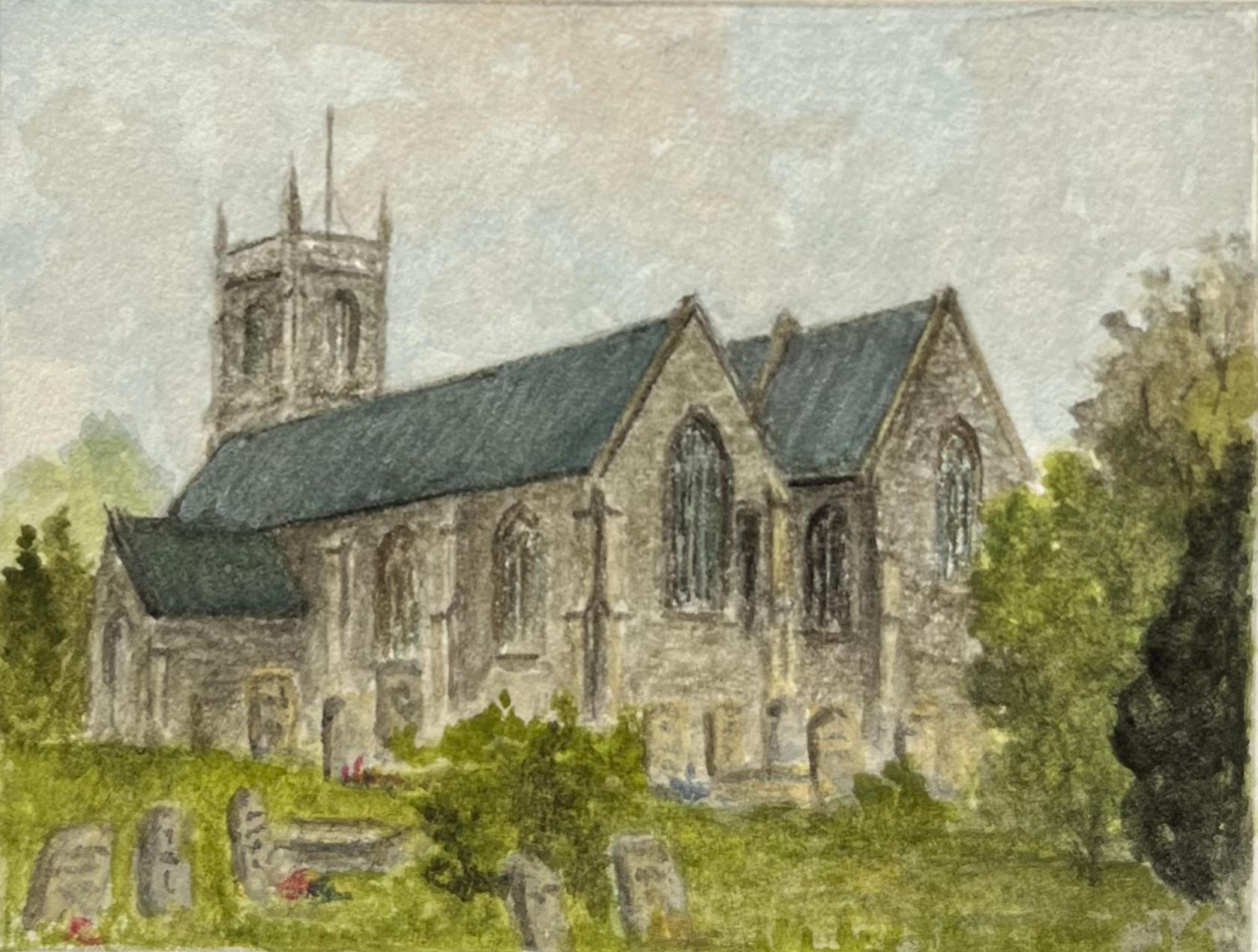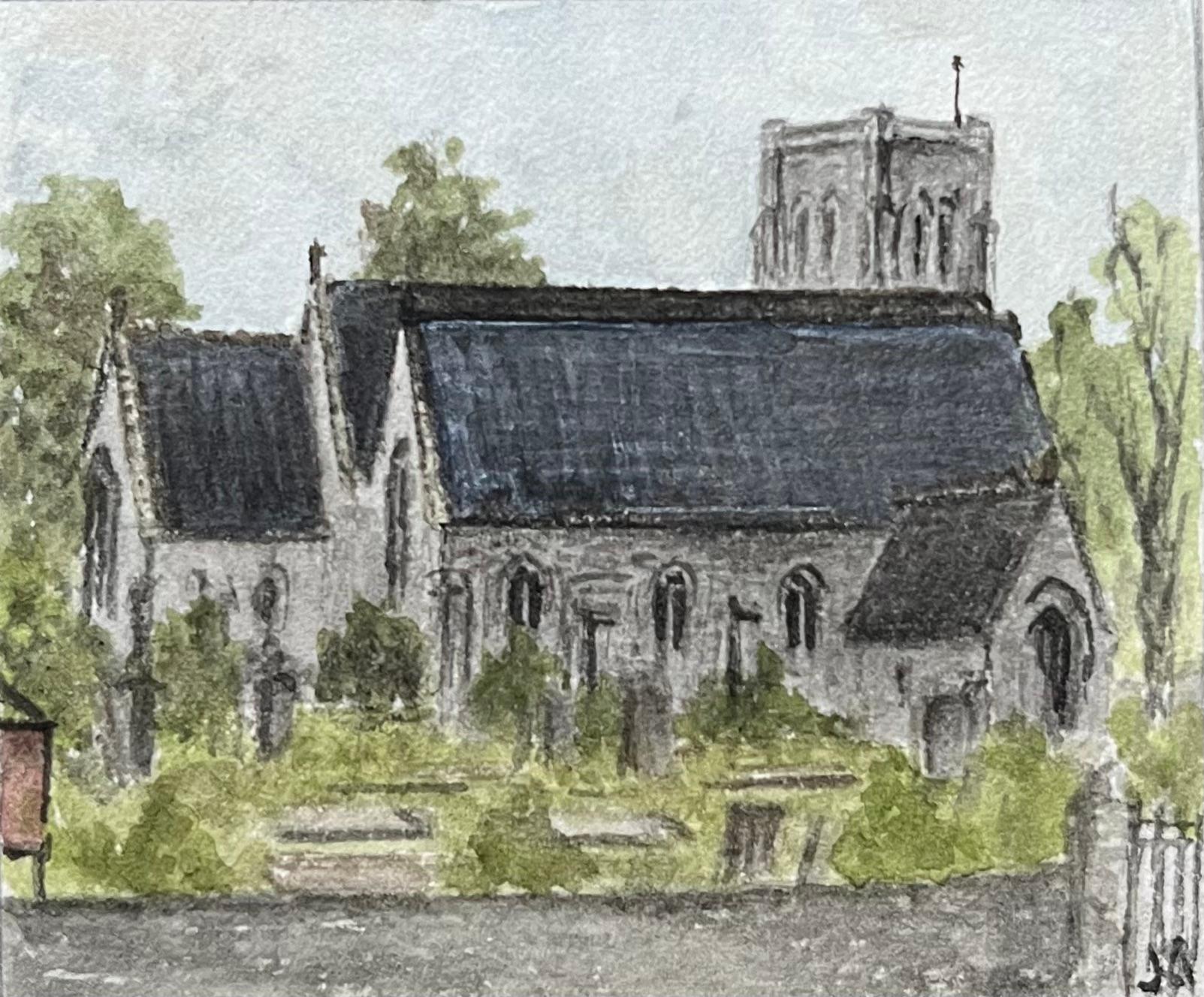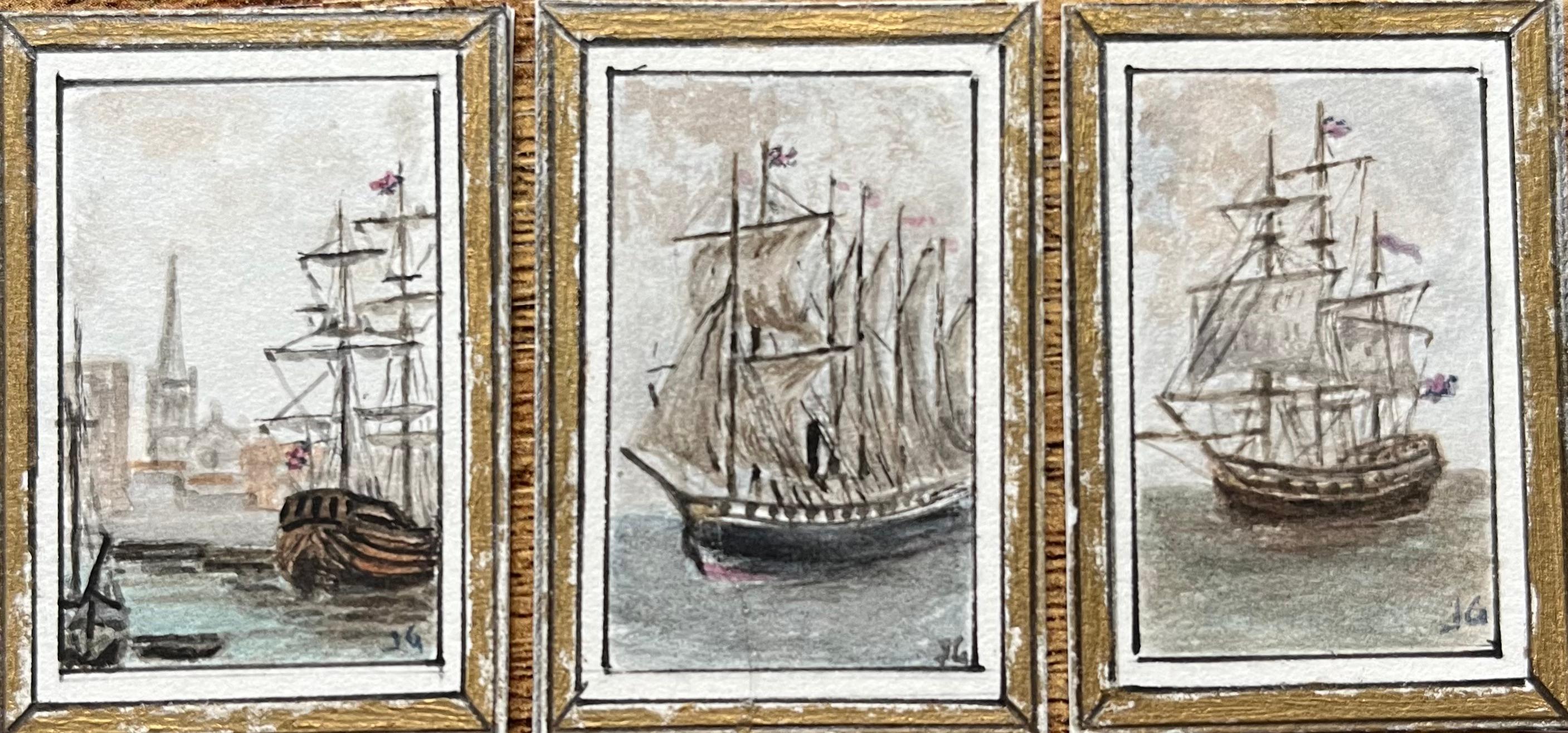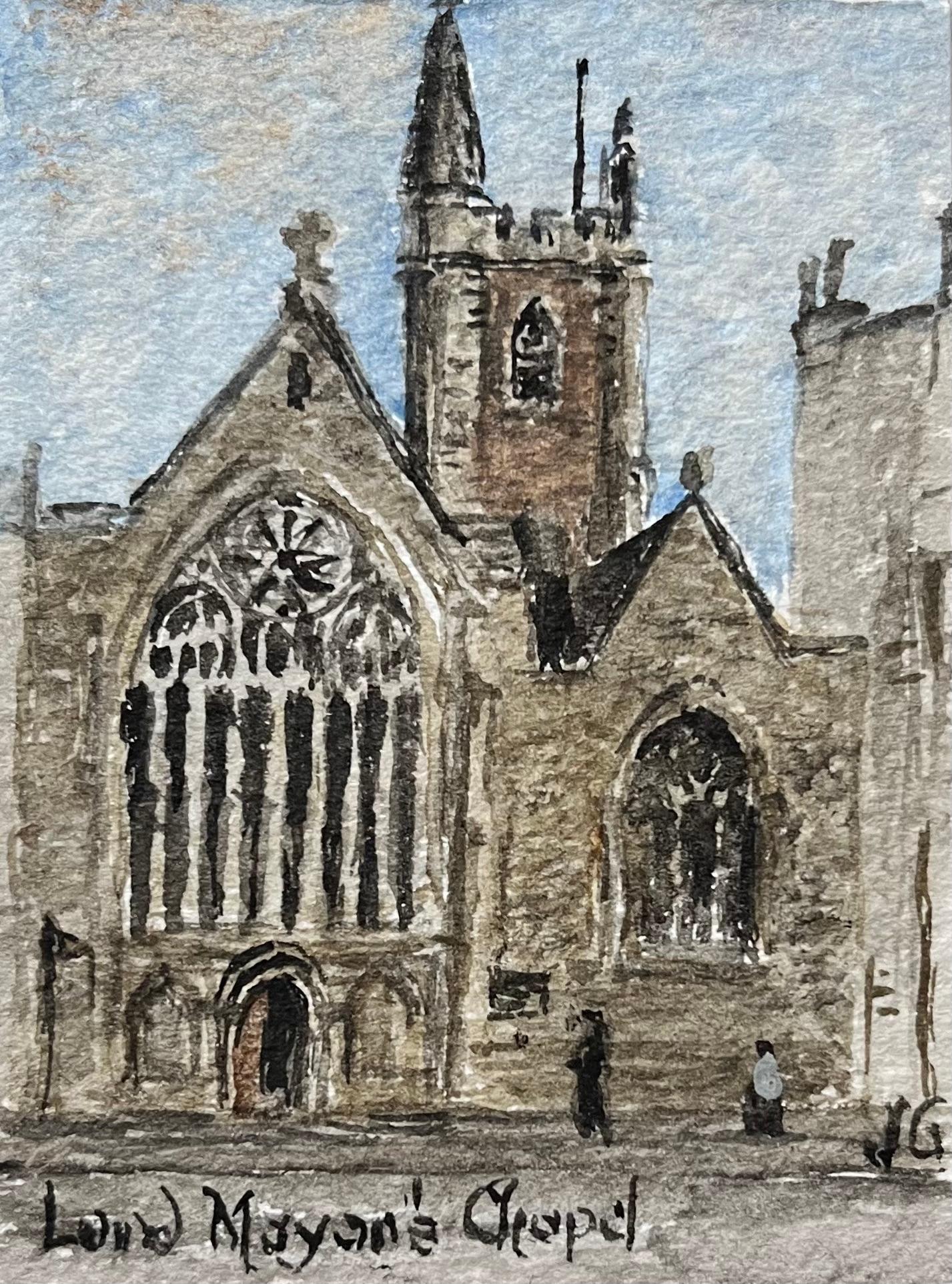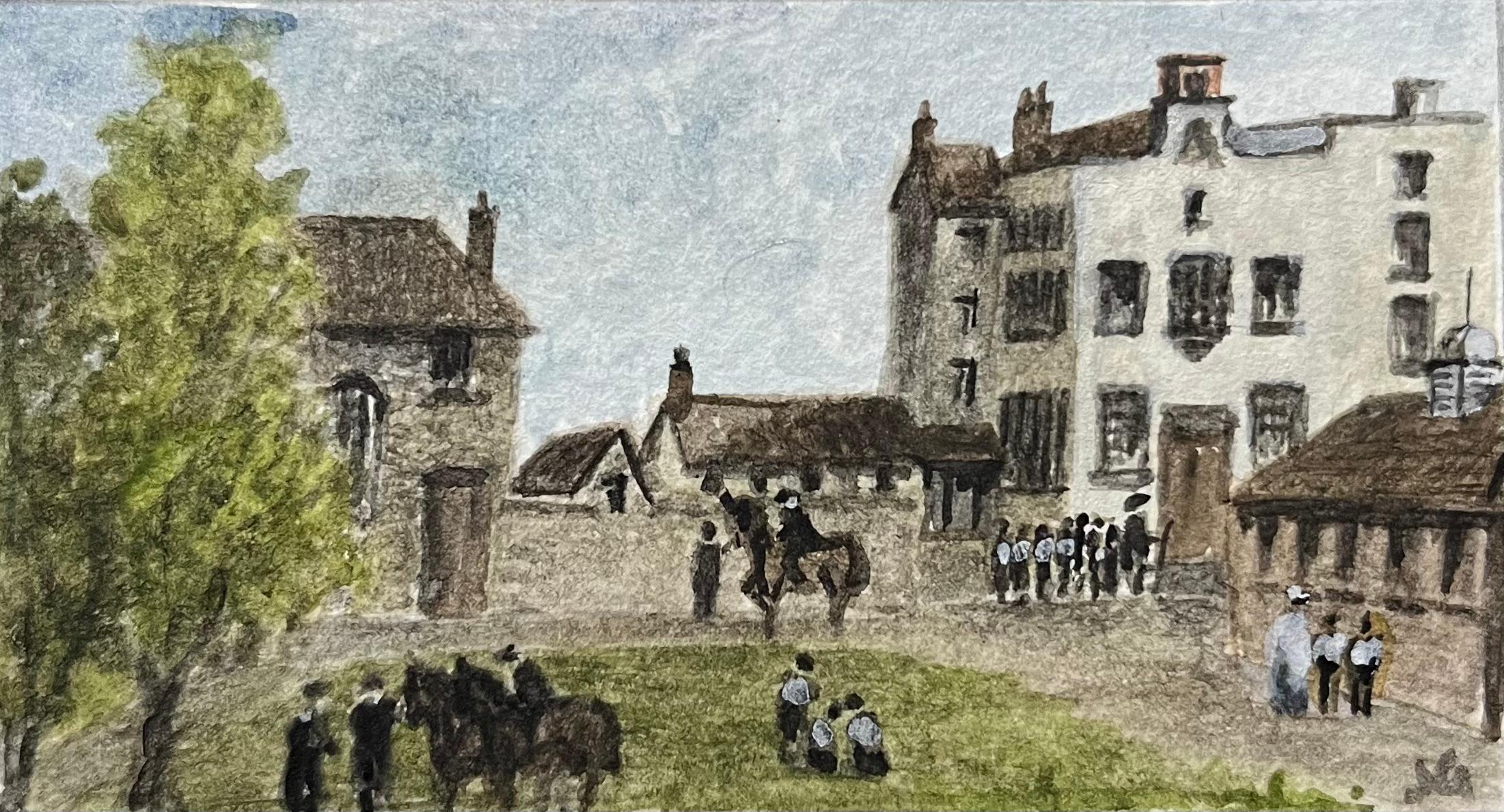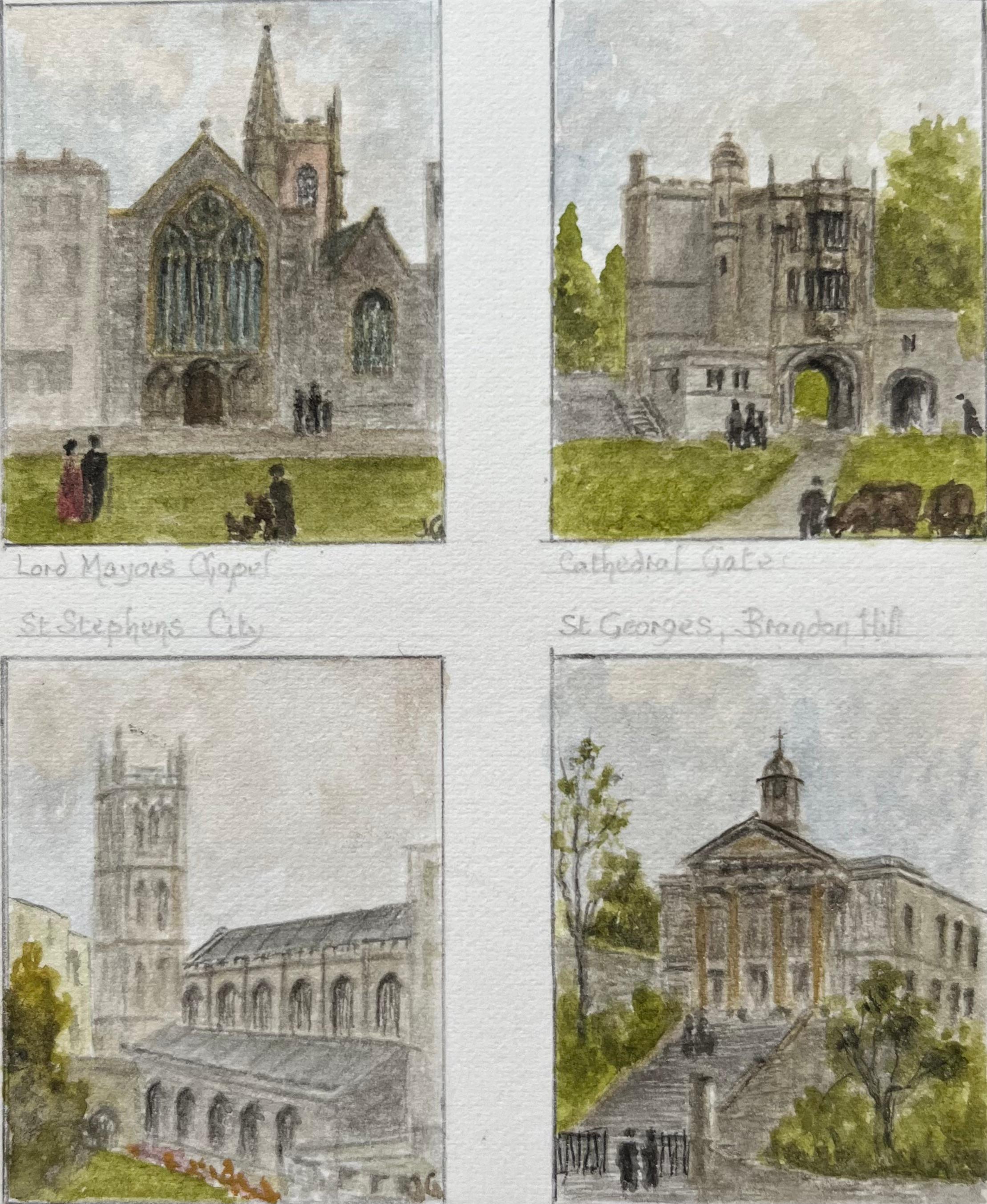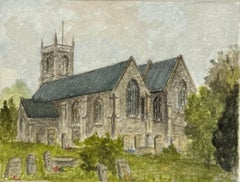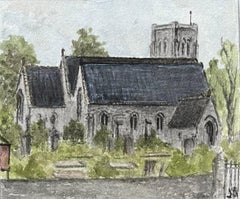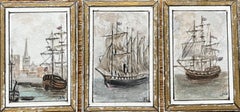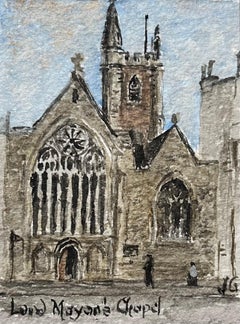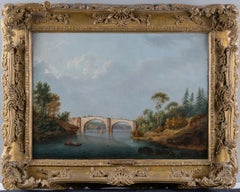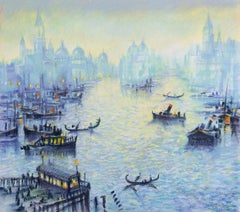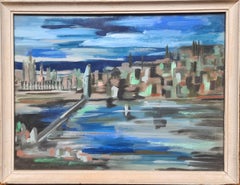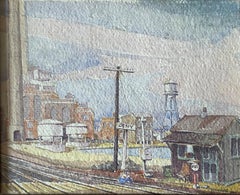Items Similar to Miniature Watercolor Paintings of St Georges Church and Cabot Tower Brandon Hill
Want more images or videos?
Request additional images or videos from the seller
1 of 6
Jack GrunwellMiniature Watercolor Paintings of St Georges Church and Cabot Tower Brandon Hill
About the Item
Title: Miniature Watercolor Paintings of St Georges Church and Cabot Tower Brandon Hill
by Jack Grunwell, 20th century British artist
Medium: Watercolor on thin card, unframed
Measurements: 3.25 inches (height) x 2.75 inches (width)
Condition: Very good and highly presentable
Provenance: from a large private collection of this artists work in Bristol, England.
Description:
This charming watercolor by Jack Grunwell captures the iconic St George’s Church and Cabot Tower, two of Bristol’s most recognizable landmarks, set within the lush greenery of Brandon Hill. The painting provides a picturesque view of the historic church, nestled among trees and rooftops, with the striking red sandstone Cabot Tower rising in the background.
Built in 1823, St George’s Church is a stunning example of Neoclassical architecture, known for its grand columned portico and elegant dome. Overlooking it, Cabot Tower, completed in 1897, commemorates the 400th anniversary of John Cabot’s voyage to North America and remains one of Bristol’s best-known landmarks.
Key Features:
Depicts St George’s Church and Cabot Tower, two historic landmarks in Brandon Hill, Bristol.
Showcases Neoclassical and Gothic Revival architecture, capturing the city’s rich architectural heritage.
Lush greenery and layered rooftops create a balanced and immersive cityscape.
Soft watercolor tones enhance the depth and atmosphere, making this a perfect piece for collectors of British cityscapes, architectural paintings, and Bristol heritage.
This artwork is an excellent addition to collections focused on Bristol landmarks, English churches, and historic urban views, offering both historical significance and artistic charm.
- Creator:Jack Grunwell (British, English)
- Dimensions:Height: 3.25 in (8.26 cm)Width: 2.75 in (6.99 cm)Depth: 1 in (2.54 cm)
- Medium:
- Movement & Style:
- Period:
- Condition:
- Gallery Location:Cirencester, GB
- Reference Number:1stDibs: LU509315787162
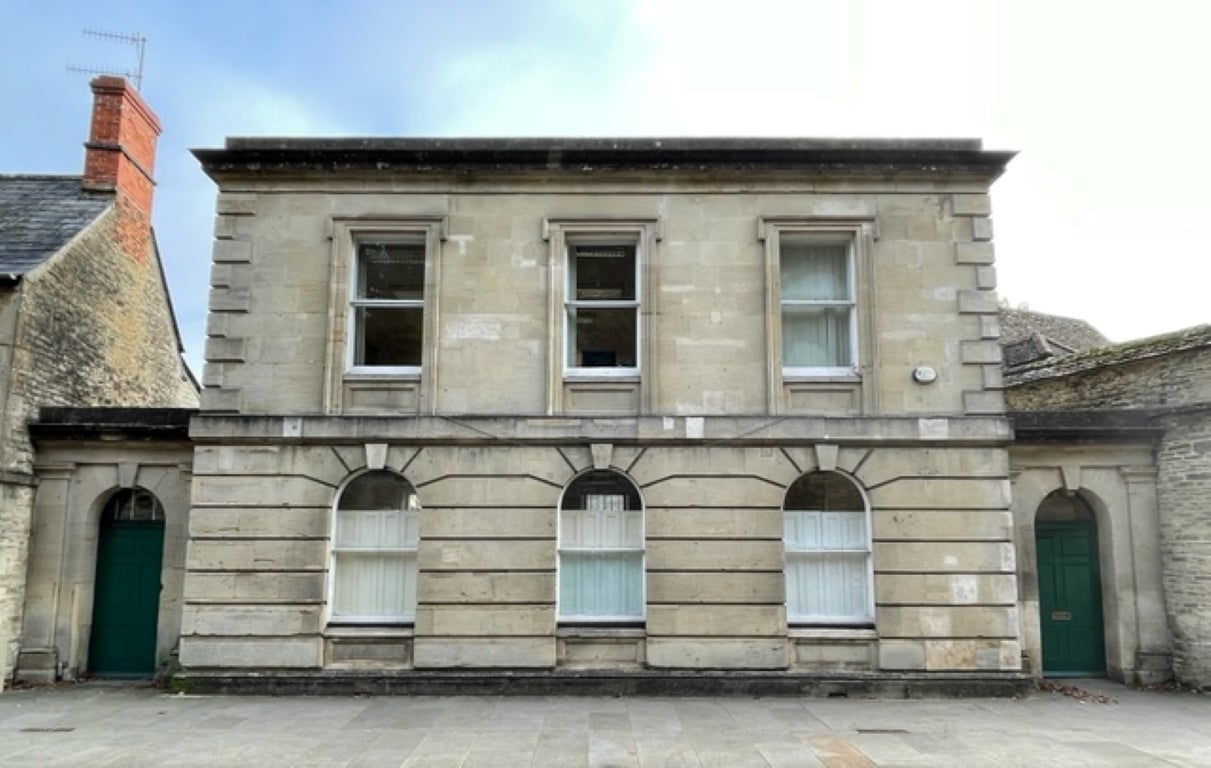
About the Seller
5.0
Platinum Seller
Premium sellers with a 4.7+ rating and 24-hour response times
Established in 1989
1stDibs seller since 2016
4,487 sales on 1stDibs
Typical response time: 1 hour
- ShippingRetrieving quote...Shipping from: Cirencester, United Kingdom
- Return Policy
Authenticity Guarantee
In the unlikely event there’s an issue with an item’s authenticity, contact us within 1 year for a full refund. DetailsMoney-Back Guarantee
If your item is not as described, is damaged in transit, or does not arrive, contact us within 7 days for a full refund. Details24-Hour Cancellation
You have a 24-hour grace period in which to reconsider your purchase, with no questions asked.Vetted Professional Sellers
Our world-class sellers must adhere to strict standards for service and quality, maintaining the integrity of our listings.Price-Match Guarantee
If you find that a seller listed the same item for a lower price elsewhere, we’ll match it.Trusted Global Delivery
Our best-in-class carrier network provides specialized shipping options worldwide, including custom delivery.More From This Seller
View AllHistoric Miniature Watercolor of St Mary the Virgin Church in Mangotsfield
Located in Cirencester, Gloucestershire
Title: Historic Miniature Watercolor of St Mary the Virgin Church in Mangotsfield
by Jack Grunwell, 20th century British artist
Medium: Watercolor on thin card, unframed
Measurement...
Category
20th Century English School Landscape Drawings and Watercolors
Materials
Watercolor
$104 Sale Price
20% Off
Miniature Watercolor of St. Michael the Archangel at Two Mile Hill
Located in Cirencester, Gloucestershire
Title: Miniature Watercolor of St. Michael the Archangel at Two Mile Hill
by Jack Grunwell, 20th century British artist
Medium: Watercolor on thin card, unframed
Measurements: 2.75 ...
Category
20th Century English School Landscape Drawings and Watercolors
Materials
Watercolor
$98 Sale Price
20% Off
Historic Miniature Watercolor Triptych of Bristol Sailing Ships
Located in Cirencester, Gloucestershire
Title: Historic Miniature Watercolor Triptych of Bristol Sailing Ships
by Jack Grunwell, 20th century British artist
Medium: Watercolor on thin card, unframed
Measurements: each min...
Category
20th Century English School Landscape Drawings and Watercolors
Materials
Watercolor
$213 Sale Price
20% Off
Historic Miniature Watercolor of Lord Mayor’s Chapel in Bristol
Located in Cirencester, Gloucestershire
Title: Historic Miniature Watercolor of Lord Mayor’s Chapel in Bristol
by Jack Grunwell, 20th century British artist
Medium: Watercolor on thin card, unframed
Measurements: 3.75 inc...
Category
20th Century English School Landscape Drawings and Watercolors
Materials
Watercolor
$108 Sale Price
20% Off
Historic Miniature Watercolor of John Wesley’s Kingswood School
Located in Cirencester, Gloucestershire
Title: Historic Miniature Watercolor of John Wesley’s Kingswood School
by Jack Grunwell, 20th century British artist
Medium: Watercolor on thin c...
Category
20th Century English School Landscape Drawings and Watercolors
Materials
Watercolor
$98 Sale Price
20% Off
Clifton Suspension Bridge and Bristol Cathedral Historic Miniature Watercolor
Located in Cirencester, Gloucestershire
Title: Clifton Suspension Bridge and Bristol Cathedral Historic Miniature Watercolor
by Jack Grunwell, 20th century British artist
Medium: Watercolor on thin card, unframed
Measurem...
Category
20th Century English School Landscape Drawings and Watercolors
Materials
Watercolor
You May Also Like
A bridge over river Oil on canvas British Inscribed William Marlow
By William Marlow
Located in London, GB
William Marlow (1740 - 1815)
A bridge over river
Oil on canvas
Inscribed, 'William Marlow' to old label verso
Provenance:
J. Palser & Sons, 27 King Street, London
Dimensions:
(Fra...
Category
Late 18th Century English School Landscape Paintings
Materials
Oil
'Venice', French Impressionist, Paris, École des Beaux-Arts, Venetian Vedute
Located in Santa Cruz, CA
Signed lower left, 'Bonnaure' for Alain Bonnaure (French, born 1941) and painted circa 1995.
When he was a young artist, Alain Bonnaure's work was purchased by the renowned French p...
Category
1990s Other Art Style Landscape Paintings
Materials
Pastel, Gouache, Laid Paper
London and the River Thames.
Located in Cotignac, FR
Modern Impressionist gouache on paper view of London and the river Thames by M K Meyer. The painting is signed bottom right and titled to the backboard 'Londres'. Presented in a plai...
Category
Late 20th Century Modern Landscape Paintings
Materials
Gouache
"Train Station, " Max Kuehne, Industrial City Scene, American Impressionism
By Max Kuehne
Located in New York, NY
Max Kuehne (1880 - 1968)
Train Station, circa 1910
Watercolor on paper
8 1/4 x 10 1/4 inches
Signed lower right
Provenance:
Private Collection, Illinois
Max Kuehne was born in Halle, Germany on November 7, 1880. During his adolescence the family immigrated to America and settled in Flushing, New York. As a young man, Max was active in rowing events, bicycle racing, swimming and sailing. After experimenting with various occupations, Kuehne decided to study art, which led him to William Merritt Chase's famous school in New York; he was trained by Chase himself, then by Kenneth Hayes Miller. Chase was at the peak of his career, and his portraits were especially in demand. Kuehne would have profited from Chase's invaluable lessons in technique, as well as his inspirational personality. Miller, only four years older than Kuehne, was another of the many artists to benefit from Chase's teachings. Even though Miller still would have been under the spell of Chase upon Kuehne's arrival, he was already experimenting with an aestheticism that went beyond Chase's realism and virtuosity of the brush. Later Miller developed a style dependent upon volumetric figures that recall Italian Renaissance prototypes.
Kuehne moved from Miller to Robert Henri in 1909. Rockwell Kent, who also studied under Chase, Miller, and Henri, expressed what he felt were their respective contributions: "As Chase had taught us to use our eyes, and Henri to enlist our hearts, Miller called on us to use our heads." (Rockwell Kent, It's Me O Lord: The Autobiography of Rockwell Kent. New York: Dodd, Mead and Co., 1955, p. 83). Henri prompted Kuehne to search out the unvarnished realities of urban living; a notable portion of Henri's stylistic formula was incorporated into his work.
Having received such a thorough foundation in art, Kuehne spent a year in Europe's major art museums to study techniques of the old masters. His son Richard named Ernest Lawson as one of Max Kuehne's European traveling companions. In 1911 Kuehne moved to New York where he maintained a studio and painted everyday scenes around him, using the rather Manet-like, dark palette of Henri.
A trip to Gloucester during the following summer engendered a brighter palette. In the words of Gallatin (1924, p. 60), during that summer Kuehne "executed some of his most successful pictures, paintings full of sunlight . . . revealing the fact that he was becoming a colorist of considerable distinction." Kuehne was away in England the year of the Armory Show (1913), where he worked on powerful, painterly seascapes on the rocky shores of Cornwall. Possibly inspired by Henri - who had discovered Madrid in 1900 then took classes there in 1906, 1908 and 1912 - Kuehne visited Spain in 1914; in all, he would spend three years there, maintaining a studio in Granada. He developed his own impressionism and a greater simplicity while in Spain, under the influence of the brilliant Mediterranean light. George Bellows convinced Kuehne to spend the summer of 1919 in Rockport, Maine (near Camden). The influence of Bellows was more than casual; he would have intensified Kuehne's commitment to paint life "in the raw" around him.
After another brief trip to Spain in 1920, Kuehne went to the other Rockport (Cape Ann, Massachusetts) where he was accepted as a member of the vigorous art colony, spearheaded by Aldro T. Hibbard. Rockport's picturesque ambiance fulfilled the needs of an artist-sailor: as a writer in the Gloucester Daily Times explained, "Max Kuehne came to Rockport to paint, but he stayed to sail." The 1920s was a boom decade for Cape Ann, as it was for the rest of the nation. Kuehne's studio in Rockport was formerly occupied by Jonas Lie.
Kuehne spent the summer of 1923 in Paris, where in July, André Breton started a brawl as the curtain went up on a play by his rival Tristan Tzara; the event signified the demise of the Dada movement. Kuehne could not relate to this avant-garde art but was apparently influenced by more traditional painters — the Fauves, Nabis, and painters such as Bonnard. Gallatin perceived a looser handling and more brilliant color in the pictures Kuehne brought back to the States in the fall. In 1926, Kuehne won the First Honorable Mention at the Carnegie Institute, and he re-exhibited there, for example, in 1937 (Before the Wind). Besides painting, Kuehne did sculpture, decorative screens, and furniture work with carved and gilded molding. In addition, he designed and carved his own frames, and John Taylor Adams encouraged Kuehne to execute etchings. Through his talents in all these media he was able to survive the Depression, and during the 1940s and 1950s these activities almost eclipsed his easel painting. In later years, Kuehne's landscapes and still-lifes show the influence of Cézanne and Bonnard, and his style changed radically.
Max Kuehne died in 1968. He exhibited his work at the National Academy of Design, the Art Institute of Chicago, the Carnegie Institute in Pittsburgh, the Memorial Art Gallery of the University of Rochester, and in various New York City galleries. Kuehne's works are in the following public collections: the Detroit Institute of Arts (Marine Headland), the Whitney Museum (Diamond Hill...
Category
1910s American Impressionist Landscape Drawings and Watercolors
Materials
Paper, Watercolor
"Trout Clouds" Watercolor Impressionist Galveston Pier Landscape Painting
Located in Houston, TX
Watercolor coastal landscape painting with fishermen on a pier. The painting is done in an impressionist style and is signed by the artist in the lower corner. On the back of the piece is the title and date. The work is framed in a light wooden frame with a tan matte.
Dimensions without Frame: H 33 in x W 24 in.
Artist Biography: Charles Criner was born in the small East Texas town...
Category
Early 2000s Contemporary Landscape Drawings and Watercolors
Materials
Watercolor
"Binocular" Large Scale Watercolor painting of the Moon
By Thomas Broadbent
Located in New York, NY
36"x72"watercolor on paper, available unframed, signed on reverse by New York artist, Thomas Broadbent. Please inquire about framing options.
This highly detailed and masterfully rendered watercolor depicts a dual view of the Moon...
Category
2010s Contemporary Landscape Drawings and Watercolors
Materials
Watercolor, Archival Paper
Recently Viewed
View AllMore Ways To Browse
St George Art
Art Neoclassical Architecture Drawings
English Church
Red Tower
Church Tower
English Landscape With Church
Church Charm
Church Hill
Miniature Painting English
Church Key
Large Neoclassical Painting
American Gothic Painting
Red Sandstone
Miniature Churches
Church Dome
St George Tower
Georges Cabot
Flowers On Canvas
